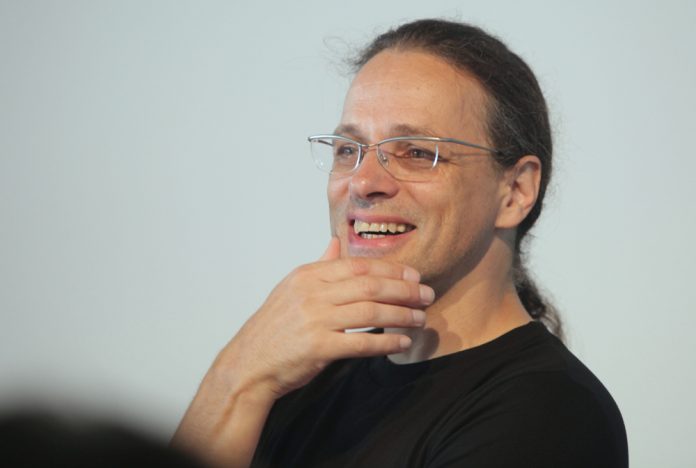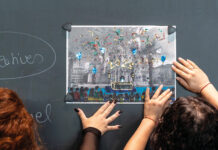
C – what it takes to change
— Gerfried Stocker
The challenges we are currently facing are too major and complex to be able to be solved by the expertise of individual groups or disciplines. Even if there is a willingness to cooperate among different groups in principle, a suitable catalyst is still needed in order to trigger a process of creative cooperation. But which models for creative cooperation also lead to innovative results?
“Knowledge, creativity, ideas: the raw materials of the future. Available for free! Word about this now really has got around, and it is being routinely and enthusiastically propagated by politics and business. Everyone is in favour of creativity, everyone wants better trained employees, and everyone wants to benefit from new ideas. Great! But who will contribute something towards this process? Who understands that these raw materials cannot just be extracted, but must also be established and built up, that they are not simply there for the taking, but require prior investment? Only when we understand the ecosystem of creativity and innovation, when we respect it and supply it with sufficient nutrients, can we hope to profit from it. Creativity and innovation don’t simply fall from the sky, and also cannot be planned into being through clever design thinking and strategic innovation management. An interdisciplinary approach cannot mean that many people share the same cake and each receives a piece, but rather that they bake the cake together, with each person bringing their own piece. Is that a platitude? Of course it is, but try telling this to the CEOs, the research and development heads, the marketing directors and culture managers, or to the policymakers. So, what is needed, and what must we do? What is actually more important, striking out on new paths or taking a different direction…”
In 2014, this pamphlet set out the theme for the Ars Electronica, the international festival for art, technology and society, which has already been held in Linz since 1979. In 2014, we devoted the entire festival, which was entitled “C – what it takes to change” to the question of what role art can play in the change and innovation processes. Here, the C did not stand for change per se, but for many different factors that are needed, naturally starting with creativity and collaboration, then also catalyst. This term has been used with increasing frequency in recent years to describe the dynamics of change and innovation.
Sure, the word “catalyst” sounds good; it’s also a term used in the sciences, and gives the vague terminology used in relation to art a dose of predictability and practicability. And that can never hurt if you suddenly want to position art not as a pleasant leisure activity or as decoration for bank foyers, but as a part of the value chain.
However, if we desist from regarding the word merely as a trendy term and immediately start to pick it to pieces – and I think in the interim there are a large number of successful examples of the potential for innovation that arises from creative, artistic approaches and practices – then it really is worth looking up what a catalyst actually is and does.
The starting point is chemistry. We still remember from school that in order to produce a chemical reaction, energy usually needs to be provided. Sometimes, however, simply too much energy is needed, and that’s where a catalyst comes into play.
A catalyst is a substance that makes it easier for the elements that you want to react to open up to each other and to create something new. Specifically, a catalyst reduces the free energy needed for a reaction without using itself up.
And this is precisely the situation in which we currently find ourselves. The challenges we are now facing are greater than the expertise of individual groups or disciplines, and we know that we must create new constellations and paradigms for collaboration in order to go beyond well-trodden paths. We must turn a state of existing side by side into one of mutual collaboration, often between ways of working or even worldviews that cannot by themselves be persuaded to work together without a high level of energy from the outside. In order for such “chemical” reactions as these to be able to take place and to lay down the essential basis for innovations, we need the almost magical properties offered by materials that Jöns Jakob Berzelius discovered in 1835 and called catalysts. 60 years later, the Nobel prizewinner Wilhelm Oswald defined a catalyst as follows: “(…) a substance that increases the speed of a chemical reaction, without itself being used up in the process (…)”. Could that not also be an excellent description of the impact of art? To make a difference, to set something in motion, allow the unexpected to unfold, and so on. An impact with which it was always credited, traditionally above all in processes of social transformation and renewal, when horizons needed to be expanded and new ideas put forward.
However, this is precisely the effect that we need for the innovation processes that we are repeatedly told are needed in technology and business. Not because the engineers might suddenly run out of ideas for solutions, but because in entirely new forms and levels of intensity we find a crossover between technological innovation and social issues and individual needs. In a world in which technology and humans (and that then always also means “product and user”) “cohabit” so closely as we are in some cases already doing, but in a way that will become incomparably more intensive over the coming decades, the standards for innovation go far beyond the original fields of engineering and design.
The motivation and conceptual framework for “the artist as catalyst” has on the one hand emerged from the practical experience of many creative innovative projects that we have gathered through the Ars Electronica FutureLab, which was founded in 1996, but also from the knowledge gained from the Prix Ars Electronica, our international competition for CyberArts, which attracts 3,000-4,000 submissions every year from all over the world – a unique observation laboratory for trends and developments in art and technology.
In the FutureLab, the in-house thinktank and prototype laboratory of Ars Electronica, not only are the exhibition projects for the Ars Electronica Center and Artists in Residence projects created for the festival, but a large number of research projects are conducted for industry.
It is due to the positioning of Ars Electronica for 37 years now at the nexus of art, technology and society – once a no-man’s land, and now a highly rated hotspot – that here, a sensitive ecosystem could be created in which work is conducted on the original artistic output as well as on creative innovation for industry that is oriented to specific assignments. The spectrum to be covered here could hardly be broader, and yet all these activities have one basic feature in common: curiosity, openness, the willingness to take risks and the highest degree of interdisciplinary composition of the respective project teams, who are not divided up along artistic and commercial lines, but who work to an equal extent in both spheres and who profit from the gains in experience and knowledge made on both sides.
These are not cooperative projects in which industry sponsors art and expects an image transfer or something to distract from everyday life in return. No, this goes beyond the creative industry metaphor, in which art becomes a craft and is sheathed in sellable products. These are models that have proven for a long time now that they are valid and necessary. If, however, we refer to artists as catalysts, more wide-reaching expectations arise, in which art can unfold its impact far beyond its own territories, and is raised to the same level as its partners from research and industry. This equal status and mutual respect are incidentally fundamental requirements in order to be able to exploit the diversity of approaches and to render it effective. It is superfluous to point out that this demands a high degree of adaptation and flexibility on both sides, and that processes of this nature also require skilful moderation. Although we should not forget that with our approach, we are still in very new, uncertain territory, even if we already have an astonishingly large number of successful projects to show for it.
The list of international corporations who are currently our partners is satisfyingly long and diverse, and includes companies such as Daimler, Honda, Toyota, BMW, Audi, VW, Siemens, Toshiba, INTEL, and SAP to name just the major international flagships, who do not subject their cooperation with art to an NDA. In an attempt to give form and method to this highly promising idea, a pioneering cooperation project has been developed in recent years. Under the “Future Catalysts” label, we are collaborating with Hakuhodo, the second-largest advertising and consultancy agency in Japan, and are testing and refining our Art Thinking project.
This is a further development of the now highly successful Design Thinking, the purpose of which is not to find solutions to specific problems, but to a far greater extent to act as a preliminary stage in this process – a stage that allows us to find our bearings in the large number of potential options and opportunities that arise as a result of the rapid, far-reaching transformation of our times, to determine our current position and to identify the relevant vectors of the future. Entirely in the spirit of the well-established description, according to which science exists in order to provide answers, but the role of art is to ask questions, we have developed the principle of Creative Questions, according to which, starting from the experimental settings of artistic projects, pluriversal future scenarios are designed and analysed. These processes take place in groups, which each consist of artists, technology specialists, social activists and entrepreneurs. Creative Questioning is here a type of reverse engineering of future scenarios, by means of which weak points can be detected, but also unseen directions and opportunities are revealed. For example, if self-driving cars are the answer, what are the questions that we need to ask along the way to producing them?
This is a comparatively simple example of the questions and decisions that we must face head on as a society. With this in mind, the C in the festival title of 2014 also stood for confidence and craving, in other words, for our trust in and yearning for change.
The author
Gerfried Stocker is a media artist and communications technology engineer. In 1991, he founded xspace, a team for realising interdisciplinary projects, who have created numerous installations and performance projects in the field of interaction, robotics and telecommunications. Since 1995, Gerfried Stocker as been artistic director of Ars Electronica. In 1995/1996, he built up a separate research and development section in the team, the Ars Electronica FutureLab. From 2004, under his leadership, the international exhibition programme Ars Electronica was established, and in 2005, work on planning and the creation of a new content focus began on the new and extended Ars Electronica Center.











